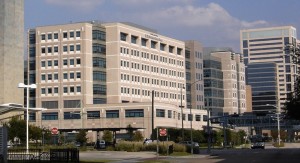
The University of Texas M. D. Anderson Cancer Center (Photographer: Zereshk)
Home of NASA’s Mission Control Center, Houston is also home to some of the best hospitals in the country. Some of the best nursing jobs in Houston can be found at the Methodist Hospital, St. Luke’s Episcopal Hospital, University of Texas M. D. Anderson Cancer Center, Memorial-Hermann Texas Medical Center and TIRR Memorial Hermann, which are all well-rated by US News and World Report, and all have high-ranking specialties.
Many Houston nursing jobs are in hospitals located on Portsmouth Street, including Bayou Medical Center, or Fannin Street, where the Women’s Hospital of Texas is located. The Shriners’ Hospital for Children and Kindred Hospital Medical Center are also located on Fannin.
Nurses working in the Houston area have salaries that are moderate as the cost of living is also somewhat middle of the road. Staff RNs average about $66,000 per annum. Licensed practical nurses average just under $42,000 per year, with CNAs averaging just under $29,000 in annual pay. All figures are from Salary.Com for 2012.
For travel nurses visiting the city, there are all sorts of places of interest to see and experience, from the Johnson Space Center to the Houston Museum of Natural Science to the Theater District and the Aquarium. Plus, there’s the Mahatma Gandhi District, the Houston Zoo and the Houston Arboretum. Sports enthusiasts will surely enjoy watching the Astros, the Rockets, and the Texans, and a pilgrimage to the Astrodome is also in order. History buffs will have fun checking out the Clayton Library and the Sam Houston Hotel, or strolling around the Fifth Ward’s Frenchtown – or taking a trip west to see the San Jacinto Battleground in La Porte, which is about a half an hour away.

Houston night skyline (Photographer: eflon)
Whether residing in Houston or visiting as a travel nurse, getting around is not too bad, as the center of the city is laid out in a grid. Interstate 45 (also known as the Gulf Freeway) cuts through and then skirts the city to the west, and then it arcs around to the north. Route 610 makes a ring around the city and then another ring, Route 8 (Beltway 8), goes around that. Route 59 proceeds from the southwest to the northeast. It eventually intersects with Interstate 10.
Houston travel nursing jobs are often in the Fannin Street area, which is to the southwest. That area is near Route 59 and Route 288.
Another popular transportation option in Houston is the comprehensive public transportation system. METRO (the Metropolitan Transit Authority of Harris County) consists of buses and regional rail. The Red Line travels from Fannin Street South to the University of Houston Downtown stop.
Housing is more expensive the closer you get to the center of things. Prices can be very high in affluent bedroom areas such as Washington Avenue and the Allen Parkway area. Prices are a bit lower outside of the city, in areas such as Tomball and Jersey Village. According to Trulia, the market is on the rise, but overall sales seem to be decreasing in early 2013. Apartment living can be in modern townhouses or developments.
Educational opportunities are plentiful, as Houston is home to a concentration of great colleges and universities. Nursing programs are available at (among others) the Houston Baptist University, Prairie View A & M and Texas Women’s University. All of these schools can improve the experience of nursing in Texas.
Houston – it’s an impressive global city. Got any more insights into living and working in Houston? Let us know in the comments section!
Make sure you don’t miss out on the latest nursing news and important announcements: Follow us on Twitter or like the Ultimate Nurse page on Facebook.

 One of the most recently revitalized cities in the United States, Indianapolis is home to some great Midwestern hospitals. Some of the best nursing jobs in Indianapolis can be found at the
One of the most recently revitalized cities in the United States, Indianapolis is home to some great Midwestern hospitals. Some of the best nursing jobs in Indianapolis can be found at the Coordination of care is not a new role for nurses, but it has never been fully appreciated. As nurses, we coordinate patient care and ease the transition from hospital to home, often preventing readmission to hospital and improving the quality of patients’ lives. Finally, this vital role is being seen as a valuable one, not just in terms of patient care, but in financial terms for nurses who perform this essential service.
Coordination of care is not a new role for nurses, but it has never been fully appreciated. As nurses, we coordinate patient care and ease the transition from hospital to home, often preventing readmission to hospital and improving the quality of patients’ lives. Finally, this vital role is being seen as a valuable one, not just in terms of patient care, but in financial terms for nurses who perform this essential service.